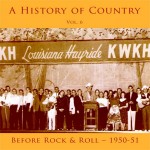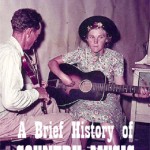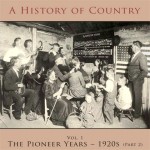A History of Country Vol. 1: Pioneer Years – 1920s
This is the first of a series in probably nine parts, aimed at providing a brief history of country music (all accompanied by an appropriate CD-sized mix). I hope it will not only inform those who have an interest in the genre, but also persuade those who resist becoming acquainted with country music to give it a chance, perhaps weakening resistance and preconceived notions which might be reduced to the stereoptypes of Confederation flags and the jargons of Hicksville. Of course it is very possible to dislike the sound of the steel guitar, the banjo, the fiddle or the yodel.
But is country all that? I would propose that country is so broad a genre that it is nearly impossible to claim to hate all of it. I hope the mixes I have prepared for each chapter will illustrate the range of country music; perhaps even help convert some sceptics. I also hope that the country fan will find things to enjoy in these mixes, even though I have tried to concentrate on music that would be representative of the era covered in the text. Even so, some of the older recordings are fairly difficult to find, I think. Special thanks to reader Rick for sourcing a couple of particularly difficult-to-find tracks.
I have consulted many sources, but I should single out two: the exquisitely compiled and illustrated book Country Music: The Complete Visual History, edited by Paul Kingsbury & Alannah Nash, and Roughstock’s History of Country Music. The Roughstock takes a different approach to the one I take here, so the histories are, I hope, complementary. Where I commit errors, I apologise. Where I emphasise one fact and omit another, feel free to share your insights in the comments section (and, of course, everybody who reads this is urged to leave a comment; even if it is a three-word feedback). And so to part 1, covering the early years before the Great Depression hit.
For the first few decades of its recorded history, country music was not even called that. Alternately, it was called things like Old Familiar Music, Hillbilly or folk, but the term “country” did not find any currency until the late 1940s. Whatever it was called and however one may define it, country music has its roots in the rural Southern Appalachian folk songs — the so-called broadside ballads, which geographical isolation had preserved for decades and even centuries — and in the minstrel shows which brought black music to white folks through the visual medium of blackface. It has its roots in the Christian revivalism of Billy Sunday (read up his story; it’s quite amazing) and Dwight Moody, in Calvinist church music, and in the gospel of the cotton fields. It has its roots in the French square dance, the quadrilles. It has its roots in the songs sung by cowboys, whose mobile lifestyle encouraged the use of small musical instruments, such as the mouth harmonica and the fiddle. And it has its roots in the popular music produced in urban New York’s Tin Pan Alley, whose songs travelled south via vaudeville shows. (For a fine series on country’s early roots, visit the River’s Invitation blog)
From the start, country was located in the South, with its socially inflexible but culturally promiscuous racial barriers. The fiddle and banjo, for example, were initially instruments of black music, though the banjo, an African instrument brought to America by slaves, was innovated on by whites to give it its present five-string form. The blues had a profound effect on country (in the 1920s and ’30s, many country songs incorporated the term blues in their titles). That, of course, did not inhibit the occasional incidence of coarse racism in country music. So it was not peculiar that the hugely popular and very influential string band Gid Tannen and the Skillet Lickers should release songs with regrettable titles like Run Nigger Run.
Still, forgotten black blues musicians such as Arnold Shultz and Rufus Payne had a huge influence on the development of country. Shultz, a fiddler and guitarist taught the future bluegrass legend Bill Monroe (I’ve heard rumours of Shultz recordings existing; but it seems that these are just a myth) and influenced the famous finger-picking guitar style of Merle Travis, while Hank Williams — perhaps country’s most pivotal figure — learned to play guitar from Payne. Bob Wills, another country pioneer with his Western Swing, incorporated the blues and jazz sounds he loved into his music. Uncle Dave Macon, meanwhile, claimed to have learned his song Rock About My Saro Jane from black stevedores along the Cumberland river in the 1880s.
The advent of accessible radio in the early 1920s was crucial in the rise of popular music, country included, as record companies started to seek new sounds. Indeed, radio was crucial in the long-term, with Nashville’s WSM Radio’s wide reach broadcasting the Grand Ole Opry shows from the city’s Ryman Auditorium almost nationwide from 1927, turning many country artists into household names even before the Opry’s syndication.
The first-ever country record was recorded on 30 June 1922 — not in a random southern location, but in New York City, at the Victor Talking Machine Company on West 38th Street. The 35-year old Texan fiddler Eck Robertson put on record several tracks, accompanied on some by Henry C Gilliland, a 70-year old Civil War veteran. After a few months, Victor chose to release Robertson’s signature song, Sally Gooden. It made no impact whatsoever, nor did the fiddler’s four follow-up releases.
The first country hit came soon after, and it was recorded in the South. In March 1922, an Atlanta radio station, WSB, invited local fiddlers and other folk string musicians — pickers — to perform in its studio. The experiment proved popular, and the star performer was Fiddlin’ John Carson. He was heard by a visiting A&R man, Ralph Peer, who three years earlier had released one of the first blues records, Mamie Smith’s Crazy Blues. Peer, a key person in the development of country music, signed up Carson for the Okeh label. On 14 June 1923, in a make-shift studio on Atlanta’s Nassau Street, Carson recorded Little Old Cabin In The Lane, a minstrel song from the 1870s written by Will S Hays. Peer thought Carson’s vocals were nothing like anything he had heard before, and not in a good way. Yet, what Peer thought was “pluperfect awful” singing would provide a template for generations of country singers. The recording was a hit.
A year later, classically-trained tenor Vernon Dalhart’s The Wreck Of The Old ’97, backed with The Prisoner’s Song, became country’s first million seller. Country music was now a commercial proposition, and Dalhart was its first superstar. New stars now popped up. Uncle Jimmy Thompson, already 78 in 1925; Uncle Dave Macon, a trucker in his 50s (whose 1924 Hill Billie Blues gave the genre one of its names); Carl T Sprague, a genuine cowboy singing genuine western music; North Carolina’s Charlie Poole (country’s first celebrity death, in 1931 at 39); Riley Puckett, who was country’s first yodeller; Gid Tannen and his Skillet Lickers (of which the blind Puckett and his fiddling collaborator Clayton McMichen were also members) . And then, in 1929, the Carter Family — A.P., his wife Sara and her cousin Maybelle (a later incarnation, after Sara and A.P. divorced, included wider family members, including Maybelle’s daughters June and Anita) — broke through with the lovely Wildwood Flower. Along with Jimmie Rodgers and Bob Wills, the Carter Family would define the sound of country music.
If Dalhart was country’s first superstar, then Jimmie Rodgers was the genre’s first mega star. Discovered and signed to the Victor label by Ralph Peer (on 1 August 1927, the same day Peer signed the Carter Family), Rodgers first recorded in 1927, and found success with the Blue Yodel, which set a theme of yodelling sequels until his death at 35 in 1933. One of these yodel songs marked the first interracial country recording, 1930’s Blue Yodel No.9 with Louis Armstrong. And there was even a black country star, the harmonica, guitar and banjo virtuoso DeFord Bailey, who regularly appeared on the Opry until 1941 when he was abruptly dismissed, but whose recording career, like that of many others (including Eck Robertson) ended with the onset of the Great Depression.
TRACKLISTING:
1. Eck Robertson – Sallie Gooden
2. Fiddlin’ John Carson – Little Old Cabin In The Lane
3. Ernest Stoneman – The Titanic
4. Vernon Dalhart – Wreck Of The Old 97
5. Charlie Poole – The Girl I Left In Sunny Tennessee
6. Carl T. Sprague – O Bury Me Not On The Lone Prairie
7. Uncle Jimmie Thompson – Lynchburg
8. Charlie Poole – There’ll Come A Time
9. Uncle Dave Macon & His Fruit Jar Drinkers – Rock About My Saro Jane
10. Gid Tanner’s Skillet Lickers – Bully Of The Town
11. Vernon Dalhart – The Dying Girl
12. Ted Chesnut – He’s Only A Miner Killed In The Ground
13. Bradley Kincaid – Barbara Allen
14. Riley Puckett & Clayton McMichen – Old Molly Hare
15. Harry McClintock – Goodbye Old Paint
16. DeFord Bailey – Davidson County Blues
17. Jimmie Rodgers – Brakeman’s Blues (Blue Yodel No.2)
18. The Carter Family – Wildwood Flower
19. Tom Darby & Jimmie Tarlton – Lonesome Railroad
20. Uncle Dave Macon – Buddy, Won’t You Roll Down The Line
21. Wendell Hall – In The Big Rock Candy Mountain
22. Jimmie Rodgers – Hobo Bill’s Last Ride
23. Bentley Boys – Down On Penny’s Farm
24. Blind Alfred Reed – How Can A Poor Man Stand Such Times And Live
25. Clarence ‘Tom’ Ashley – The House Carpenter
(includes front and back covers. PW here)
.














Thanks
great stuff. looking forward to the rest
Extremely impressive research–looking forward to the next installments.
Brilliant post. So much research. Thanks for all your hard work
You do such great work here, Amd! Muchisimas gracias.
Thanks! This is going to be a great series.
Well done Dude, i been wondering how this series would turn out, i think i would have a really tough time summing up any one decade with just one mix, Cheers Rick
Abbout damn time someone paid some overdue homage to country music. Too much of it lays strewn about or shrugged off by elitist snobs. Loved it.
Thanks so much. Fantastic work (and music).
wonderful. and interesting. I wasn’t aware that Armstrong had something to do with blue yodel !
This looks brilliant G-Dude, I’ve just ordered that “Complete Visual History” again – the last time you tipped me off about it, it never turned up. Ta very much!
Thanks for the time and effort that you put into the posting to bring this sad but vital piece of history to our attention.
Regards
Rhod
This is a dream come true. Really fantastic. Thanks.
Fantastic Series–I downloaded them all! THANK YOU.